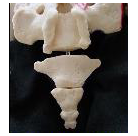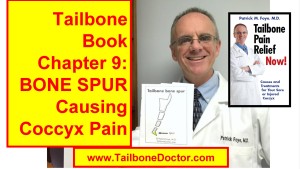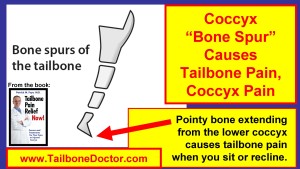Tailbone Book, Chapter 9: Coccyx Bone Spur (Tailbone Spicule) Causing Coccyx Pain
- This is the next in a series of coccyx pain videos, giving you highlights from the chapters of Dr. Foye’s book, “Tailbone Pain Relief Now!”
The actual VIDEO is at the bottom of this page.
Here is the TEXT from the video:
- Hi. I’m Dr. Patrick Foye.
- I’m an M.D., or Medical Doctor, and I’m the Director of the Coccyx Pain Center or Tailbone Pain Center here in the United States.
- I’m online at www.TailboneDoctor.com.
- In this video we’re going to talk about bone spurs causing tailbone pain or coccyx pain.
- This is the next in my series of videos going chapter by chapter through my book “Tailbone Pain Relief Now!” to share some of the information that’s in each chapter.
- To do that in a video format that’s available online as it is here allows us to interact more because you can post comments or questions or your stories down below this video.
- So this now is Chapter 9 within my book.
- So Chapter 9 is Bone Spurs Causing Tailbone Pain.
- So what we’ll cover in this video is what is a bone spur, how does it happen, what is it made of, where is it located within the coccyx and how does it cause pain.
- We’ll talk about a few other aspects as well.
- So first of all what is a bone spur?
- A bone spur is when there’s a little bit of additional bony material beyond the normal amount.
- One thing I compare this to sometimes is: if you think about when you get calluses on your hands or feet. There’s thickening of the skin that causes a callus of the skin.
- Well, similarly there can be thickening of the bone causing a callus of the bone and when that callus is located in a particular way that it forms a point that is called a bone spur.
- Or some of my colleagues in Europe often will refer to it as a bone spicule.
- It’s the same thing.
- So if I show you here an illustration from the book probably will do a good job of showing you what we’re talking about here.
- So basically this is a side view of the coccyx or tailbone.
- So if we looked at the coccyx like the sacrum and coccyx like this normally you can see how the tailbone curves forward into the pelvis.
- But now in this case it starts curving forward.
- But you can see here down on the lower end there’s a little bit of extra bone.
- I’ve highlighted in yellow here on the illustration just to make it more clear where there’s a little bit of extra bony material there.
- That is a bone spur or a bone spicule.
- And it’s often relatively small.
- So you could say maybe smaller than the size of a pea or a pebble.
- But it can cause a lot of pain.
- Just like the same way that a small pebble within your shoe would be very, very painful if you were walking on that all day.
- Every time you put your body weight on it you would obviously have a lot of pain in your foot after a while from doing that.
- And similarly when you have a bone spur the size of a pebble down here at the lower tip of the coccyx that can cause a lot of pain as well.
- Because every time that you go to sit down basically you’re sitting… if this is… I’ll have the book represent the chair.
- Here you go to sit and now you’re going to be pinching the skin in between the bone spur and the chair that you’re sitting on.
- And especially if you sit leaning partway back you’re really going to be poking that bone spur down on the skin and down towards the chair.
- So the bone spur itself is made of bone.
- It is bone just like the callus that you have on your hands or feet is made of skin.
- It is skin.
- So a bone spur is made of bone.
- It’s a thickening of the bone that forms a focal point.
- And where does it occur at the tailbone the vast majority of the time?
- It is located down at the lowest tip of a tailbone.
- So the lowest tip of the coccyx is the spot where you see the bone spur most commonly.
- And the other question that comes up is well… what direction… if it’s coming to a point, what direction is that pointing typically?
- It’s pointing behind you.
- So it’s pointing backwards.
- So back to our anatomic model here again…
- This would be a model of the sacrum and down here is the coccyx.
- You can see the whole thing is curving forward.
- But if there was a bone spur it would be pointing back the other way.
- The bone spur would be pointing back that way, the way that the pen is showing here.
- So that’s a little bit about what the bone spur is made of, and where it’s located, and the direction that it points, and the way that it causes pain especially when you’re tilted leaning back.
- But even with sitting upright it can often be very painful as well.
- The things that are done to treat the bone spur we’re going to talk about in some of the later videos when we’re talking about treatments of various types of tailbone pain.
- The book is sort of divided so that the first half of the book is about the diagnosis and what it is that causes tailbone pain, and goes through a variety of different causes.
- And it’s super important that prior to starting treatment that you actually have a sense of what it is that’s causing your tailbone pain in the first place.
- How is that assessment made when we’re looking at bone spurs? There’s two or three main ways.
- Number one of course is listening to the patient’s symptoms.
- They have pain at the coccyx.
- Right in that area.
- Pain with sitting, pain with sitting leaning part way back.
- Sometimes they may have some pain during transitions from sitting to standing but those things are true about most causes of tailbone pain.
- The ways that you would distinguish that the bone spur specifically would be… Number one, on physical examination if the physician is careful while they are touching even just pressing externally along the back of the sacrum and the back of the coccyx if there was a spur right here where my finger is you may be able to feel that projection coming backwards.
- It’s almost pointing if this patient was laying on the table here and they’re facing down towards the floor or the table their back is pointing up towards the ceiling.
- And in this example the bone spur would be here pointing somewhat up towards the ceiling.
- And just from a careful physical exam just gently pressing along the back wall of the sacrum and coccyx you can kind of walk your finger down and and you can sometimes feel the spur pointing upwards.
- So another way you can assess for that is by getting imaging studies.
- Most commonly that’s done by x-rays or radiographs.
- And it’s important that they do the side view and not the front view because the side view will show you that silhouette that will show if there is a bone spur sort of sticking out.
- And we’ll talk more in another video covering another chapter about the different tests that are done for tailbone pain.
- You can see it on x-rays, MRI CT scans, etc but only if any of those tests are done properly.
- Unfortunately a large percentage of the time the imaging studies are NOT done properly.
- So that’s a general scoop about bone spurs causing tailbone pain.
- Obviously there’s a lot more information within that chapter within the book.
- But I wanted this video to provide us an opportunity to generally cover the topic.
- And also for you to post your comments down below.
- Comments or questions or thoughts.
- Or if you’ve had a bone spur someplace else… at your shoulder or sometimes people get them on the sole of their foot with plantar fasciitis.
- It’s the same idea that that bone spur, that pointy projection of bone, starts to pinch things.
- So if it’s your shoulder it pinches into the rotator cuff muscles when you try to reach up overhead.
- At the sole of the foot it pinches the skin when you take that first step in the morning and press down.
- It can pinch the soft tissue structures on the sole of the foot.
- So that’s a little bit about bone spurs.
- Post your comments down below and if you’re interested in getting the the book itself the easiest way to get that is to go to the website www.TailboneBook.com.
- It is available on Amazon, but if you go to www.TailboneBook.com it will give you the direct link for the Amazon site for your country.
- Whether you’re getting the e-book (which is available worldwide you do not need an e-book reader. You can just read it online.)
- So anyplace that has internet access you can get the e-book and also the paper copy.
- The softcover copy you can get through Amazon.
- And again use the links at www.TailboneBook.com.
- If you’re looking for me generally the easiest way to find me online is at my website which is www.TailboneDoctor.com.
Here is the actual VIDEO:
Here is the screenshot thumbnail image for the video:
To get your copy of the book “Tailbone Pain Relief Now!” go to: www.TailboneBook.com
For more information on coccyx pain, or to be evaluated at Dr. Foye’s Tailbone Pain Center in the United States, go to: www.TailboneDoctor.com
Latest posts by Patrick Foye, M.D. (see all)
- Coccygectomy: Expected Recovery and Return to Work after surgery for coccyx pain, tailbone pain. - November 28, 2023
- PRP Platelet Rich Plasma or Prolotherapy for Tailbone Pain, Coccyx Pain - October 25, 2023
- Reasons for Normal X-rays and MRI Despite Tailbone Pain, Coccyx Pain - October 3, 2023



